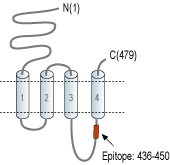Overview
- Peptide (C)KDHKATNSKGSEWKK, corresponding to amino acid residues 436-450 of rat nAChRα9 (Accession P43144). 2nd intracellular loop.

 Western blot analysis of mouse (lanes 1 and 3) and rat (lanes 2 and 4) brain lysates:1,2. Anti-Nicotinic Acetylcholine Receptor α9 (CHRNA9) Antibody (#ANC-019), (1:400).
Western blot analysis of mouse (lanes 1 and 3) and rat (lanes 2 and 4) brain lysates:1,2. Anti-Nicotinic Acetylcholine Receptor α9 (CHRNA9) Antibody (#ANC-019), (1:400).
3,4. Anti-Nicotinic Acetylcholine Receptor α9 (CHRNA9) Antibody, preincubated with Nicotinic Acetylcholine Receptor α9/CHRNA9 Blocking Peptide (#BLP-NC019).
 Expression of nAChRα9 in rat DRGImmunohistochemical staining of rat dorsal root ganglion (DRG) frozen sections using Anti-Nicotinic Acetylcholine Receptor α9 (CHRNA9) Antibody (#ANC-019), (1:400), followed by goat-anti-rabbit-AlexaFluor-488. nAChRα9 staining (in green) appears in neuronal soma (arrows). DAPI is used as the counterstain (blue).
Expression of nAChRα9 in rat DRGImmunohistochemical staining of rat dorsal root ganglion (DRG) frozen sections using Anti-Nicotinic Acetylcholine Receptor α9 (CHRNA9) Antibody (#ANC-019), (1:400), followed by goat-anti-rabbit-AlexaFluor-488. nAChRα9 staining (in green) appears in neuronal soma (arrows). DAPI is used as the counterstain (blue).
- Lustig, L.R. et al. (2006) Anat. Rec. A Discov. Mol. Cell. Evol. Biol. 288, 424.
- McIntosh, J.M. et al. (2009) Biochem. Pharmacol. 78, 693.
- Filchakova, O. et al. (2013) PLoS One. 8, e64655.
The nicotinic acetylcholine receptors (nAChRs) are ionotropic multi-subunit, neurotransmitter-gated receptors of the cholinergic system. These receptors are responsible for mediating the effects of the neurotransmitter acetylcholine (ACh). They are assembled from one or more α subunits (α1-α10) alone or together with one or more β subunits (β1–β4).
The receptors are also a target of the biologic compound nicotine, which mostly mimics the effects of acetylcholine on the receptors by binding as an agonist to α subunit of nAChRs.
nAChRs play critical physiologic roles in the central and peripheral nervous systems. They regulate neurotransmitter release, cell excitability, neuronal integration, and are involved in functions such as sleep and arousal patterns, fatigue, hunger, anxiety, and pain processing1,2.
The structure of each subunit is composed of an extracellular domain, which harbors the binding site, four transmembrane α-helices (TM1–4), and a variable intracellular region4. The α subunits have a defining “cysteine loop” that contains two vicinal cysteine residues3.
nAChRs containing the α9 subunit are expressed in a variety of non-neuronal tissues starting from immune cells to breast carcinomas. The α9 subunit is able to form a functional homomeric receptor and in addition to co-assemble with the α10 subunit into functional heteromeric nAChRs3.
α9-containing nAChRs play an important role in pain, inflammation, keratinocyte adhesion and in mediating synaptic transmission between the efferent olivocochlear fibers and cochlear hair cells3.
nAChRs are involved in pathologies, such as myasthenia, epilepsy, schizophrenia, Parkinson’s disease, autism, dementia with Lewy bodies, Alzheimer’s disease, and addiction3.
Application key:
Species reactivity key:
Alomone Labs is pleased to offer a highly specific antibody directed against an epitope of rat nAChRα9. Anti-Nicotinic Acetylcholine Receptor α9 (CHRNA9) Antibody (#ANC-019) can be used western blot and immunohistochemistry applications. It has been designed to recognize nAChRα9 from human, rat and mouse samples.
